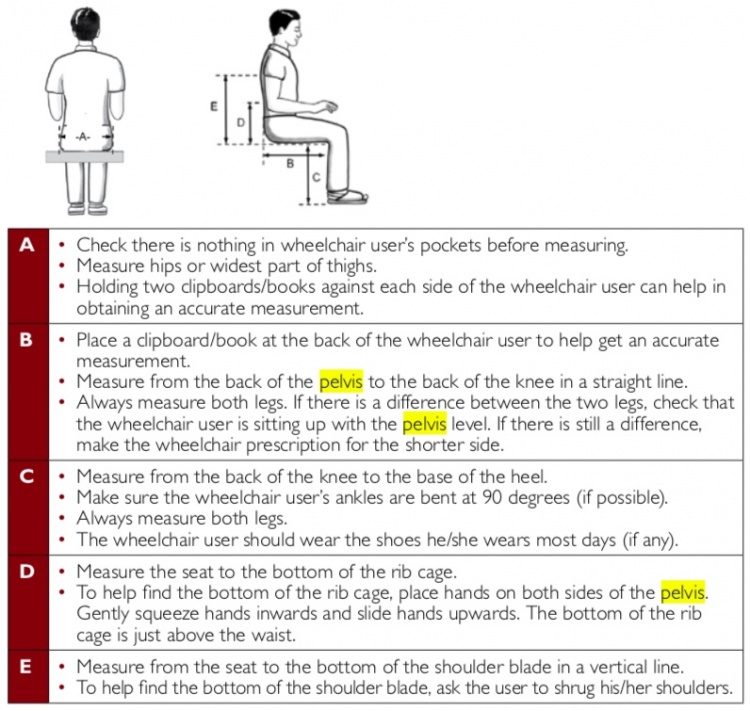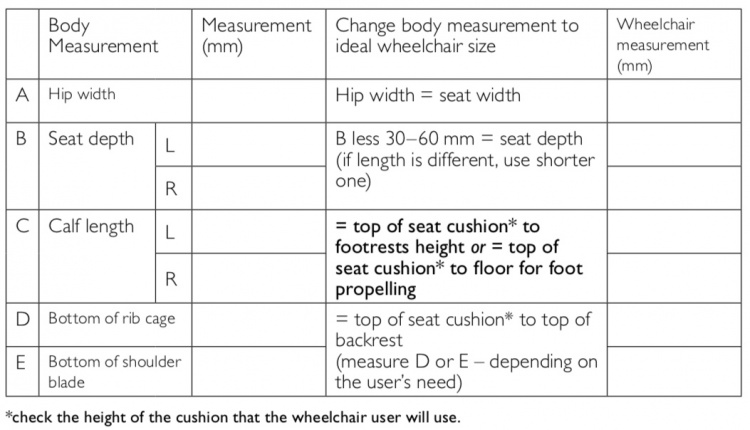Wheelchair Assessment - Body Measurements
Original Editor - Your name will be added here if you created the original content for this page.
Top Contributors - Naomi O'Reilly, Rucha Gadgil, Amrita Patro, Olajumoke Ogunleye and Kim Jackson
Introduction[edit | edit source]
A well-fitted wheelchair or seating system requires a ‘made-to-measure’ solution. Generally, the more seating surface that is in contact with the client, the more body measurements that will need to be obtained for a wheelchair prescription. Accurate measurement of the client will enable clinicians to allow the wheelchair user to trial correctly sized equipment, reduce the number of transfers and improve time management during trials by pre-setting the seating and wheelchair according to body measurement prior to an appointment. It will also ensure an accurate reference for the final wheelchair configuration during the prescription phase or any future equipment trials where applicable. Finally it will assist the wheelchair service personnel to outline the clinical reasoning behind the specifications of wheelchair prescriptions in funding applications. [1][2]
Measuring Tools[edit | edit source]
- Use a retractable metal tape measure
- clipboards/books can be used to help measure accurately (see process below).
- Large callipers are an additional tool that can be very useful. These can be made locally from wood.
- Foot-blocks can also be used to support the wheelchair user’s feet at the correct height. [1]
Basic Measurements[edit | edit source]
Six measurements from the wheelchair user are needed to choose the best available size of wheelchair for for a wheelchair user that has good trunk control and does not require additional postural support.[1][3]
- Seat Width; Measured from the widest aspect of the user’s buttocks, hips or thigh. It should be wide enough to avoid pressure on the hips.
- Seat Depth; Measured from the user’s posterior buttock, along the lateral thigh to the popliteal fold with your palm horizontal to the seat. Usually, a space of about 2 inches is preserved to avoid pressure from the front edge of the seat against the popliteal space. You should be able to fit 3-4 fingers between the front edge of the seat and the back of your knee.
- Seat Height; Determined by the height of the individual and if the wheelchair is self-propelled. When using the feet to propel, the seat height should allow for them to reach the floor with their heel. Those using footrests have higher seat heights. It is measured from the user’s heel to the popliteal fold. The bottom of the footrest is 2 inches from the floor.
- Armrest Height; Should allow user sit erect, with level shoulders when bearing weight on the forearms as they rest on the armrest.It is determined by measuring the distance between the seat of the chair and olecranon and adding one inch.
- Backrest Height; The inferior angles of the scapula should be approximately 1 finger-breadth above the back when the user sits with erect posture. It is determined by measuring the distance between the seat of the chair to the patient’s axilla, and subtracting four inches. The height of the backrest depends on the needs of the user. Wheelchair users who push themselves need a backrest which allows their shoulders to move freely. Wheelchair users who have difficulty sitting upright may need a higher backrest which gives more support to the spine.
- Footrest Length; Affects the support of both the feet and the thighs and the clearance of the footplates and the ground. The footplate must be about 1 to 2 inches off the ground to permit adequate ground clearance.
Process[edit | edit source]
Ask the wheelchair user to sit as upright as possible with the wheelchair user’s feet supported either on the floor or on foot-blocks if they cannot reach the floor comfortably with the hips in a neutral position. For all measurements, make sure the tape measure is held straight and the wheelchair user is sitting upright. Holding a clipboard/book on either side of the wheelchair user can help in obtaining an accurate measurement. Bend down to ensure you are viewing the tape measure at the correct angle.[1]Intermediate Measurements[edit | edit source]
Measuring a wheelchair user to select the correct wheelchair size and location of PSDs. On the measurements part of the intermediate wheelchair assessment form there are twelve body measurements listed. Five measurements are the same measurements as above in the Basic measurements. One additional backrest height body measurement is added to the intermediate wheelchair assessment form. Seat to top of shoulder measurement is used to measure a wheelchair user for a high backrest. There are six more measurements, which will help to decide the size and/or location of PSDs. Sometimes it may be necessary to take more measurements, depending on the PSDs prescribed. There is space on the intermediate wheelchair assessment form to record ‘other’ measurements. [2]
Resources[edit | edit source]
References[edit | edit source]
- ↑ 1.0 1.1 1.2 1.3 Sarah Frost, Kylie Mines, Jamie Noon, Elsje Scheffler, and Rebecca Jackson Stoeckle. Wheelchair Service Training Package - Reference Manual for Participants - Basic Level. World Health Organization, Geneva. 2012
- ↑ 2.0 2.1 Sarah Frost, Kylie Mines, Jamie Noon, Elsje Scheffler, and Rebecca Jackson Stoeckle. Wheelchair Service Training Package - Reference Manual for Participants - Intermediate Level. World Health Organization, Geneva. 2013
- ↑ Fairchild, Sherly L, Pierson and Fairchild’s Principles & Techniques of Patient Care, 5th edition, 2013








